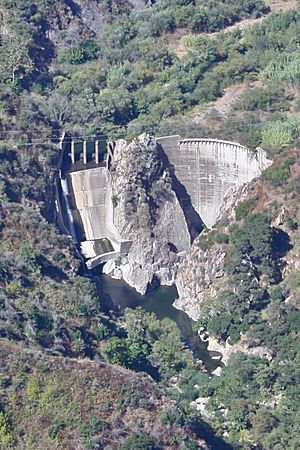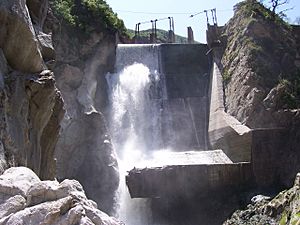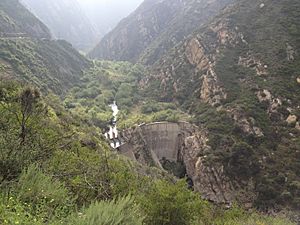Rindge Dam facts for kids
Quick facts for kids Rindge Dam |
|
|---|---|

Rindge Dam, seen from Piuma Road
|
|
| Location | Malibu Creek State Park |
| Coordinates | 34°03′53″N 118°41′58″W / 34.064594°N 118.699328°W |
| Opening date | 1924 |
| Owner(s) | May Knight Rindge, California Department of Parks and Recreation |
| Dam and spillways | |
| Type of dam | Concrete thin arch |
| Impounds | Malibu Creek |
| Height | 100 feet (30 m) |
The Rindge Dam is a large dam, about 100-foot-tall (30 m), located on Malibu Creek. This creek flows through the Santa Monica Mountains in Southern California. The dam is found inside Malibu Creek State Park. It is just northeast of Malibu Canyon Road. You can see parts of it from certain spots near the road. This dam has been a big problem for local river animals. Because of this, it is being removed, with work starting in 2025 and expected to finish in 2035.
Contents
Building the Dam
The Rindge Dam was built by workers hired by May Knight Rindge. She owned a large area called the Malibu Ranch. This ranch used to be known as Rancho Topanga Malibu Sequit.
The dam's main structure was made using rails from a railroad. This railroad, called the Hueneme, Malibu and Port Los Angeles Railway, was about 15-mile long (24 km). May Rindge had built it across her Malibu Ranch.
The dam's two walls were built into a natural rock formation in the middle of Malibu Creek. These walls only met at the very top. The main concrete arch of the Rindge Dam was completed in 1924. The part of the dam that lets extra water flow over, called the spillway, was finished in 1926.
By around 1950, the area behind the dam, which was about 600 acres (240 ha), had completely filled up with dirt and sand. This created a waterfall where Malibu Creek now flows over the dam. In 1976, the dam became part of Malibu Creek State Park.
Why the Dam is Being Removed
Many people who care about fish have asked for the dam to be taken down. This is because it stops Steelhead trout from swimming upstream. These fish need to reach the higher parts of the Malibu Creek watershed to lay their eggs.
Some people wanted the Rindge Dam to be named a California Historical Landmark. However, this did not happen. The dam belongs to the California Department of Parks and Recreation. It has been in poor condition for many years. Because it was unsafe, the dam was closed to the public in 2014.
The US House of Representatives approved a study about removing the dam in 1992. The US Army Corps of Engineers then released a plan in January 2017. This plan was called the "Malibu Creek Ecosystem Restoration Feasibility Study." It was estimated that taking down the dam could cost as much as $80 million.
The Plan to Remove the Dam
On March 9, 2018, the California Coastal Commission approved a plan to remove Rindge Dam. This plan was created by the Army Corps of Engineers. It suggests taking down the dam's arch and spillway. It also involves removing about 780,000 cubic yards (600,000 m3) of dirt and sand that has built up behind the dam.
About 278,000 cubic yards (213,000 m3) of clean, sandy material will be moved by truck to Ventura Harbor. There, it will be checked for pollution. Then, it will be placed by a boat into shallow ocean waters. This will happen near the mouth of Malibu Creek, east of Malibu Pier. The sand will be placed carefully to avoid harming nearby kelp beds. It is hoped that this sand will eventually move towards the shore and help rebuild nearby beaches. The rest of the dirt will be taken to the Calabasas Landfill.
The project will also fix or remove other things that block fish. These are mostly pipes under roads, called culverts. They stop fish from moving along Cold Creek and Las Virgenes Creek. These creeks are smaller streams that flow into Malibu Creek, upstream from the dam. The project began in 2025 and is expected to take eight years to complete.
Challenges and Other Dam Removals
There are some risks with removing the dam. The ground where the dam and dirt are taken away might become unstable. There is also a chance of more flooding downstream from the dam. People living downstream and the City of Malibu have shared their worries about these risks.
In 2019, an organization called California Trout listed Rindge Dam as one of its top five dams to remove. Other dams on this list include Scott Dam on the Eel River, Matilija Dam near Ojai, four hydroelectric dams on the Klamath River, and Searsville Dam near Stanford University. The Matilija Dam, built in 1947, also blocks steelhead trout from their spawning grounds. It is also planned for removal. It was built to store water and control floods, but it no longer works for these purposes because it has filled up with silt.
In April 2023, California State Parks announced that the dam removal would definitely happen. The plans, engineering, and permits are expected to be almost finished by 2026. The process will involve removing about 15-foot (4.6 m) of plants and dirt. Then, the dam will be lowered. This process will be repeated after each winter, when rain brings more dirt into the area.
See also



